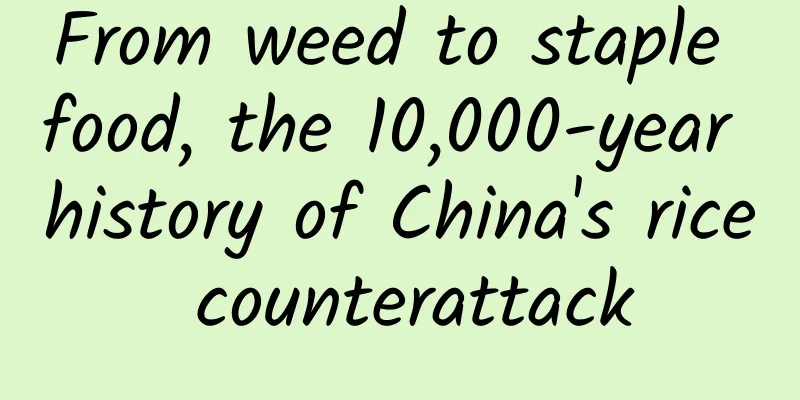From weed to staple food, the 10,000-year history of China's rice counterattack

|
From weed to staple food, the history of China's rice counterattack Rice is one of the most important food crops in the world. It provides a staple food source for more than half of the world's population. In my country, rice is also the most important food crop, with a very long history of cultivation. In the Book of Songs, which was written more than 2,000 years ago, there are descriptions of rice. For example, in the "Bin Feng·July", it is written that "rice is harvested in October, and spring wine is made for this, to celebrate the birthday of the ancestors". In the "Zhou Song·Feng Nian", it is said that "in a good year, there is plenty of millet and rice, and there are also high granaries, with tens of billions of rice. Make wine and sweet wine, and offer it to the ancestors". The "rice" here also means rice. In addition, there is a saying in the Analects of Confucius: "Eating rice and wearing brocade, what is the use of women?" These all show that rice has played an important role in ancient Chinese society. Of course, rice has been domesticated by humans for a very long time, long before writing appeared, so there has been a long debate about where rice was first cultivated. Layers of evidence reveal the origins of rice cultivation In the 1930s, Soviet botanist and geneticist Nikolay Vavilov proposed that the domestication of plants around the world was not random, and there must have been some areas where domestication first began. These areas were called "centers of origin." However, Vavilov believed at the time that rice may have originated in India and that rice in China was also introduced from India. Later, Japanese scholar Shigekata Kato discovered through research that rice consists of two subspecies, indica rice and japonica rice, and named them "Indian type" and "Japanese type" respectively. But later, with the emergence of archaeological evidence, China became the earliest place with evidence of domesticated and cultivated rice. In 1973, archaeologists discovered a cultural site dating back more than 7,000 years in Yuyao, China, in the middle and lower reaches of the Yangtze River. Here, scientists unearthed a large amount of rice and a large number of farming tools for harvesting. These evidences have changed the views of many scholars on the origin of rice. In 1985, the "Pengtoushan Site" was discovered in Li County, Changde City, Hunan Province. The Pengtoushan culture dates back 8,200 to 9,400 years. In the Pengtoushan culture, people also found rice remains. This pushed the history of rice domestication in our country back one or two thousand years. In some archaeological excavations from the 1990s to the early 21st century, scientists also discovered some "millennium rice". For example, the Xianren Cave Site and Diaobenghuan Site in Jiangxi Province, and the Shangshan Site in Zhejiang Province, have all unearthed rice grains dating back tens of thousands of years. In 2004, scientists discovered five carbonized rice grains during the excavation of the Yuchanyan site in Dao County, Yongzhou City, Hunan Province. These rice grains are special rice varieties with combined characteristics of wild, indica and japonica rice, and retain the original traits of the early evolution of ordinary wild rice to cultivated rice. These rice grains are about 14,000 to 18,000 years old and are the earliest artificially cultivated rice discovered in the world so far. In addition, some scientists use molecular biology methods to find the origin of rice. For example, in 2012, a team led by Han Bin, a geneticist at the Shanghai Institute of Life Sciences of the Chinese Academy of Sciences, compared the genomes of more than 1,000 domesticated rice varieties and more than 400 wild varieties. The results showed that both indica and japonica rice are most closely related to wild varieties growing in the Pearl River Basin. Therefore, it is speculated that the Pearl River Basin in our country may be the earliest area to domesticate and cultivate rice. Unfortunately, no relevant archaeological evidence has been discovered in the Pearl River Basin, so this statement remains to be verified. But it can be said that based on current archaeological and genomic evidence, our country is most likely the first country to domesticate and cultivate rice. Improving planting techniques to benefit neighbors As a country with a long history of rice cultivation, our hardworking people have been constantly exploring and improving rice cultivation techniques through long-term practice. As mentioned above, the comment on rice in the Analects of Confucius: Yang Hu is “Eating rice and wearing brocade, what is good for you?” This sentence is actually Confucius criticizing his disciples for eating rice and wearing brocade during the period of mourning. This shows that rice was still a “high-end food” in the Spring and Autumn Period. However, at the end of the Ming Dynasty, Song Yingxing mentioned in "The Exploitation of the Works of Nature": "Today, among the crops that feed the people, rice accounts for seven-tenths, while millet, sorghum, and millet account for three-tenths." This shows that by the Ming Dynasty, rice had become the main food crop and its popularity had greatly increased. The ancient Chinese people not only improved rice-growing techniques, but also spread these techniques to neighboring countries and regions. For example, in Southeast Asia, such as Vietnam, there is also a very long history of rice cultivation. During the Han Dynasty, Ren Yan, who served as the governor of Jiuzhen, spread the advanced technology and iron tools from the Central Plains to the local area. These technologies and tools promoted the development of local agriculture. In addition, China's agricultural production tools, such as keel waterwheels (turning carts) and drum carts, have also been introduced to Vietnam and surrounding areas. These technologies have played an important role in improving local agricultural production efficiency. In addition, about 3,000 years ago, rice from China was introduced to Japan. Although Japanese scholars still have controversy over the route by which rice was introduced to Japan, and are unsure whether it entered Japan via the Northeast and the Korean Peninsula, or was directly introduced to Japan by water from China's southeastern coastal areas, they all undoubtedly acknowledge the fact that rice was introduced from China. "Rice Power" solves global food problem As the "big rice country" with the longest history and the highest rice production, China's rice technology has not only achieved food self-sufficiency domestically, but also plays an important role in global food security. China's rich experience and advanced technology in rice cultivation continue to provide valuable support for agricultural development around the world. Academician Yuan Longping, known as the "Father of Hybrid Rice", successfully developed and promoted hybrid rice technology. This groundbreaking technology has greatly increased rice production and effectively solved China's food security problem. More importantly, this technology has been praised by the Food and Agriculture Organization of the United Nations as "the preferred strategic measure to solve food shortages in developing countries." Academician Yuan Longping's contribution is not only in science, but also in the well-being of all mankind. Today, with the advancement of science and technology and the strengthening of international cooperation, China's rice cultivation technology will continue to provide a solid guarantee for global food security. China's efforts in promoting agricultural science and technology innovation and international cooperation demonstrate the responsibility of a responsible major country and its far-reaching impact on the common future of mankind. References: 1. http://www.zys.moa.gov.cn/mhsh/202104/t20210422_6366373.htm 2. http://www.xinhuanet.com/politics/2020-12/08/c_1126834755.htm 3. http://www.sky.yn.gov.cn/xsyj/zgsd/2096919733444455652 4. Gong Tingting. Research on the origin, domestication and spread of rice in China[D]. Minzu University of China, 2017. 5. https://www.cas.cn/zt/kjzt/zykjfmcz/201609/t20160901_4573458.shtml Author: Tian Dawei, a popular science writer Reviewer: Wang Hongzhi, Associate Professor, School of Humanities, Shanghai Normal University The article is produced by Science Popularization China-Creation Cultivation Program. Please indicate the source when reprinting. |
>>: It’s Paris again. How come Paris can embrace the Olympic flame three times?
Recommend
Talking about the development of large iOS projects
The title is a bit scary, please don't be afr...
How do Auntie, Integrity Selection, and Hot Mama Gang promote and operate?
Dayima COO Erzhuo: 1. When launching a new mobile...
Build your own site group from scratch: you only need to spare 1-2 days a month, and earn about 20,000 yuan a month
Build your own site group from scratch: you only ...
5G commercialization may be advanced to 2019, and the industry chain will face great challenges
In the previously announced 5G development timeta...
Girl, do you play Momo?
Hey, add me Some time ago, I registered two accou...
Android Tencent Video v7.9.3 removes ads and unlocks Blu-ray quality_Taoduoduo
Go to play video ads Remove some advertising push...
60 technical experiences summarized in daily Android development
[[181259]] 1. All Activities can inherit from Bas...
Cameras also need to be "both inside and outside" Tesla monitors human-machine interaction
Recently, according to the electrek website, at t...
The methodology for launching hot-selling products on Douyin!
In July, a super skin care product quickly became...
Analyze the development of NetEase Cloud Music and QQ Music from the perspective of operation and business model!
O. Analysis Outline Figure 1. NetEase Cloud Music...
Which WeChat mini program production company is the best in Lanzhou? Which company is good at WeChat mini-programs in Lanzhou?
Which WeChat mini program production company is t...
New App Promotion Techniques: Video Promotion Makes Your App Popular Overnight
Everyone on the Internet is familiar with Chai Ji...
Can eating boiled vegetables help you lose weight? 7 weight loss rumors that you believe are harming your health
Author: Ruan Guangfeng, Deputy Director of Kexin ...
up to date! Baidu information flow product manual!
This article shares with you the latest "Bai...
Logical structure thinking training camp course
Improve the clarity of thinking and problem-solvi...









